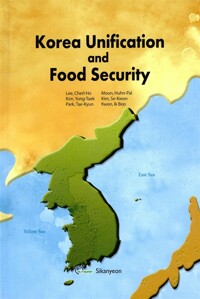
Korea unification and food security
- 발행사항
- Seoul: Sikanyeon, 2015
- 형태사항
- 354p. :. illustrations;. 24cm
- ISBN
- 9791186396247
- 청구기호
- 338.19 Y51k
소장정보
| 위치 | 등록번호 | 청구기호 / 출력 | 상태 | 반납예정일 |
|---|---|---|---|---|
이용 가능 (1) | ||||
| 1자료실 | G0016551 | 대출가능 | - | |
- 등록번호
- G0016551
- 상태/반납예정일
- 대출가능
- -
- 위치/청구기호(출력)
- 1자료실
책 소개
Unification of the Korean peninsula has long been the Korean people's desired goal. Recently, several signs of hope have spurred predictions within South Korea as well as globally regarding an impending unification. To date, there have been debates over estimates of the cost of a unification or post-unification administrative organization, but specific research is lacking regarding food supply or food security plans, which are fundamental to national management.
In May 2011 the Korea Food Security Research Foundation conducted a year-long study with a research team formed by six experts, "Food Security and Food Industry Development Strategy after Unification of the Korean Peninsula." Assuming the year of unification as 2015, their research forecast the prospects of food production and food supply and demand on the Korean peninsula immediately after unification and 10 years after unification by analyzing the current food and nutrition statuses in the North and South. Unlike previous studies, which were limited to agriculture, this research estimated the food demand and potential production capacity after unification by including food industries with agriculture and fisheries.
It is clear that food-related issues will be one of the top priorities in a post-unification government. It is necessary to establish concrete policies for food security after unification in order to help reduce the dependency on food imports in South Korea and to reverse the food shortage in North Korea. It is also necessary to propose a direction for long-term food policies in order to manage the changes in food trends and ultimately secure food sovereignty on the Korean peninsula in a post-unification era. This book was written with the aim of providing useful data that will contribute to such policymaking. It compiles the research reports of the Korea Food Security Research Foundation and includes reports of
the discussion panels from the "Seminar on Food Security and Food Industry Development Strategy after Unification of the Korean Peninsula" held on July 3, 2012.
목차
Table of Contents
Chapter 1 Introduction
1.1. Conditions for Korean Unification
1.2. Food Aid to North Korea
1.3. Circumstances of Korean Unification
1.4. Changes in Demography and the Industrial Structure of North and South Korea
Chapter 2 Food and Nutritional Status of North and South Korea
2.1. Comparison of Health and Nutritional Status between North and South Koreans
2.2. Structure and Status of Food Supply in North and South Korea
2.3. Optimal Food and Nutrition Models for Koreans
Chapter 3 Assessment of Food Production Potential on the Korean Peninsula
3.1. Status and Circumstances of Food Production in North Korea
3.2. Status of Food Production and Measurements of Production Increase in North Korea
3.3. Measures to Increase Food Production in South Korea
3.4. Measures to Increase Food Production in Post-Unification Era
Chapter 4 Assessment of the Production Potential of Fisheries in North and South Korea
4.1. Supply and Demand of Fishery Products in North and South Korea
4.2. Assessment of Fisheries Production Potential of North Korea
4.3. Local Specialties and Expected Competitiveness of the Fisheries Industry in a Post-Unification Era
4.4. Fishery Policies in Preparation for Unification
Chapter 5 Food Supply and Demand Outlook in Post-Unification Korea
5.1. Food Supply and Demand Outlook for North Korea
5.2. Food Supply and Demand Outlook for South Korea
5.3. Food Supply and Demand Outlook for the Korean Peninsula
5.4. Summary and Policy Implications
Chapter 6 Status of the Food Industry in North and South Korea and Food Security Functionality
6.1. Status of the Food Industry in South Korea
6.2. Status of the Food Industry in North Korea
6.3. Food Security Function of the Food Industry
Chapter 7 Changes in Size and Development of the Food Industry in a Post-Unification Era
7.1. Prediction of Changes in Food Industry Size in a Post-Unification Era
7.2. Outlook for the Food Ingredients Industry in a Post-Unification Era
7.3. Status of North Korean Ports
7.4. Status and Outlook of Electricity Supply on the Korean Peninsula
7.5. Outlook for the Food Industry in a Post-Unification Era
Chapter 8 Expert Reviews of Korean Unification and Food Security
8.1. Kwon Tae-Jin (Director, Center for North Korean and Northeast Asian Studies, GS&J Institute)
8.2. Choi Geun-Won (Director, Food Management Division, Korea Agro-Fisheries & Food Trade Corp. (aT))
8.3. Kim Kyung-Ryang (Professor, Department of Agricultural Resource Economics, Kangwon National University) 8.4. Yang Seung-Ryong (Professor, Food Resource Economics Department, Korea University)
8.5. Kang Myeong-Ok (Secretary General, The Korean Association of People Sharing Love)
8.6. Marc Simkins (Dean, Culinary-MBA Program, Woosong University)
Chapter 9 Policy Recommendations
9.1. Prepare for Food Shortages in the Early Stages of Unification
9.2. Maintain Rice Production and Self-sufficiency in Rice
9.3. Increase Soybean Production and Achieve Self-sufficiency in Soybeans for Food Use
9.4. Rationalize Animal Husbandry and Increase Self-sufficiency in Rough Feed
9.5. Vitalize Offshore Fisheries by Developing Marine Resources and Modernizing Marine Technology
9.6. Establish a Regional Specialization Plan to Connect Agro-fisheries to the Processing Industry
9.7. Secure Food through North-South Cooperation Projects before Unification
9.8. Take Unification as an Opportunity to Improve the Food and Nutritional Status of Koreans
